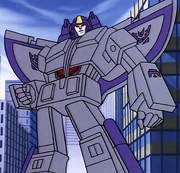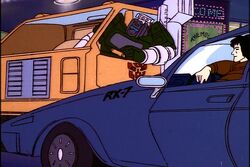
A little known fact, but Wasp is Soundwave's cousin.
Although scale has never exactly been a deep concern when it comes to Transformers, given that the series has featured F-15 jets not much larger than sports cars, it is not uncommon for certain Transformers to clearly and deliberately change size when transforming from one mode to the next. The methods employed for this startling alteration in physicality have differed from timeline to timeline, and have long been a heavily debated aspect of Cybertronian technology.
| “ | Decepticons Skywarp and Thundercracker transform and land. A tape player, three cassette tapes and a Walther P-38 fly forth from the towering twin titans. And astonishingly they enlarge hundreds of times over and change into Soundwave, Megatron, Frenzy, and Ravage! | ” |
—Narrator, Prisoner of War! | ||
Examples[]
Note that many of the Transformers named here have also transformed at certain times without shrinking or enlarging, retaining an alternate mode to scale with their robot mode. It doesn't help mass-shifting logic though. If anything it only results in more questions.
Shrinking[]
The most famous examples of size-changing Transformers are Megatron, who becomes a pistol, and Soundwave and Blaster, who both become stereo cassette players. These Transformers visibly shrink as they transform, assuming one of two sizes -— one that allows another Transformer to wield or operate them, and another, even smaller size that allows them to be transported in car-alts or used by humans.
Other shrinking Transformers include Perceptor, the Mini-Cassettes, the three mechs who make up Reflector, and in some continuities, the Insecticons. Reflector could be considered one of the worst, since that's three Transformers slightly over human-size combining into one form that's small enough for other robots - or humans - to take photographs with.
Overkill's Transformers Universe bio notes that he has a defect in his transformation circuitry, which often results in him not being able to complete his transformation by not growing back to his robot mode's full size.
One of Deep Cover's abilities is being able to shrink to 1/40th his size for brief periods of time.
Enlarging[]

Astrotrain
Conversely, Transformers have been known to grow in size when assuming their alternate modes -— the most prominent example is surely Astrotrain, whose space shuttle mode could become large enough to convey a whole contingent of Decepticon warriors, and even allow Devastator to form inside him without even bumping his head. Similarly, Broadside transforms from a robot of roughly average size (occasionally depicted as somewhat tall, but never huge) into a jet and then into an entire aircraft carrier, of the type used to transport dozens of jets. Ratchet is another good example, who has been able to transport whole Autobots in the back of his ambulance form during the cartoon, even Powerglide, who turns into a jet. Other Transformers that enlarge in such a manner also generally do so for the purposes of transporting others; they include Omega Supreme, Skyfire, and Cosmos.
Combiners are often larger in their combined form than their robot modes would otherwise indicate -— in fact, in the episode "Chaos," Predaking is explicitly shown to enlarge after his combination is complete.
In the original animated series many of the Transformers arguably enlarged or shrank in vehicle mode to a lesser extent, this is most notable among groups such as the Decepticon jets and minibots, whose altmodes could not possibly turn into robots that are the size they are depicted otherwise. Whether this was truly intended to indicate actual size changes, was merely "lazy animation", or was simply a stylistic choice designed to emphasize the awesome stature of robot mode Cybertronians, is a matter of individual opinion.
Implicit size changing[]

Mass displacement my boron compressor.
Transformers that act as transport for other Transformers often implicitly change size to do so. However, size changing is rarely explicitly depicted in these cases. Instead, the following method is used: A character such as Astrotrain transforms in-frame from robot to shuttle with no visible expansion of size relative to his surroundings. Cut. In the following shot his fellow Decepticons are shown running into frame, suddenly relatively tiny in stature so that they can board the shuttle. Although Astrotrain has not been shown to actually grow, one has to infer that this is more likely than that all his confederates have individually shrunk.
The same change-in-scale-via-implicit-size-changing is used with Omega Supreme and other characters used as transport. For example, in the episode "Make Tracks", Hoist, who is depicted as one of the larger Autobots in robot mode, is shown riding inside Huffer, a Minibot whose truck mode is usually depicted as being smaller than Optimus Prime's. So either Huffer is extremely large in that scene, or Hoist is suddenly the size of a human.
(The other explanation is that the animators simply hoped no one would notice the sudden change in scale. Since Transformers is usually targeted at kids, there's probably some truth to this.)
Explanations[]
Although size-changing has been evident in Transformers from the very beginning, the original animated series and comic books never address the topic, and it was regarded as simply being the way of things. Fandom debate on the topic has seemingly inspired later fiction to offer varying explanations on how it functions.
Fandom explanations[]

Just when you thought you had it all figured out...
The issue of shrinking and enlarging was, in the early days of the online Transformers fandom, a frequently debated subject. The Transformers were clearly displacing their mass, to allow their shrunken forms to be operable—so where was that mass going? The postulated answer to this question was the invention of "subspace", the void of extradimensional space between realities. Subspace proved a handy answer to various other questions as well - see the concept's own article for details. IDW's "mass displacement" rationale essentially is the subspace explanation, without actually using the term.
And hey, if any of that doesn't grab you, a wizard did it.
Note[]
References[]
| This page uses content from Transformers Wiki. The original article was at Size changing. The list of authors can be seen in the page history. As with Transformers Universe MUX, the text of Transformers Wiki is available under the Creative Commons License. |
